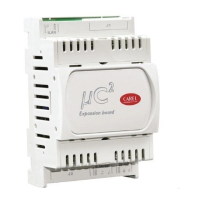A2: allarme antigelo circuito 2
Come A1 ma per il circuito 2
Ht: avviso di alta temperatura
La segnalazione viene attivata se si supera la soglia (letta da B1)
riportata nel parametro P16. Esso è ritardato all’accensione dal
parametro P17 e provoca l’accensione del relè d’allarme e del buzzer
senza la disattivazione delle uscite ed il suo ripristino è automatico al
rientrare delle condizioni che lo hanno generato.
Lt: avviso bassa temperatura
Qualora la macchina sia ad espansione diretta (H01=0, 1) l’allarme
viene utilizzato per rilevare una eventuale bassa temperatura ambiente
tramite la sonda B1 o B2 (dipende dal param. A06). Il ripristino di
questo allarme può essere manuale o automatico e dipende dal
parametro P05. in presenza dell’espansione verrà attivato il relativo
relè, in caso di solo modulo µC
2
, verrà utilizzato il relè di allarme.
AHt: avviso alta temperatura all’avvio dell’impianto.
L’avviso non attiva il relè e visualizza sul display il messaggio “AHt”.
ALt: avviso bassa temperatura all’avvio dell’impianto
L’avviso non attiva il relè e visualizza sul display il messaggio “ALt”.
ELS/EHS: avviso bassa/allarme alta tensione di alimentazione
In caso la tensione di alimentazione sia troppo bassa o troppo alta, compare
il messaggio relativo sul display, non garantendo il corretto funzionamento
del µC
2
. La bassa tensione comporta l’esecuzione solo delle richieste
di spegnimento dei carichi. Eventuali richieste di accensione rimangono
pendenti. L’alta tensione invece porta allo spegnimento di tutti i relè eccitati.
L: Avviso condizione di basso carico
L’avviso non attiva il relè e visualizza sul display il messaggio “ L ” ed è
a ripristino automatico.
D1: segnalazione defrost circuito 1
Durante il defrost sul display appare l’indicazione D1 nel caso il circuito
interessato sia il n. 1.
D2: segnalazione defrost circuito 2
Durante il defrost sul display appare l’indicazione D2 nel caso il circuito
interessato sia il n. 2.
Driver
Tutti gli allarmi del driver che bloccano l’unità, per il µC
2
sono ad
autoripristino. Per cui la possibilità di scegliere l’autoripristino dell’intero
sistema dev’essere selezionabile dal Driver stesso tramite opportuni
parametri. Il µC
2
può dare il comando Go Ahead secondo la solita
procedura di ripristino allarmi da tastiera.
Ed1: errore di comunicazione tLAN con il Driver 1
L’allarme viene generato dopo un tempo fisso (5 s) da quando il µC
2
ha
perso contatto con il Driver 1.
In questo caso il circuito 1 viene inibito per sicurezza.
Ed2: errore di comunicazione tLAN con il Driver 2 (tramite scheda
espansione)
Come Ed1 ma per il driver 2.
SH1: allarme di basso surriscaldamento circuito 1
l’allarme di basso surriscaldamento del circuito 1, dopo un tempo fisso
(5 s) inibisce il circuito 1 per sicurezza.
Il rischio è che i compressori vengano allagati.
SH2: allarme di basso surriscaldamento circuito 2
Come SH1 ma per il driver 2
nO1: avviso MOP (massima pressione operativa) circuito 1
Appare l’avviso sul display e in caso di presenza della scheda di
A2: antifreeze alarm circuit 2
As for A1 but relating to circuit 2
Ht: high temperature warning
This alarm is activated when the threshold is exceeded (read by B1),
set for the parameter P16. It is delayed at power ON by the parameter
P17 and causes the activation of the alarm relay and the buzzer, without
deactivating the outputs. It is reset automatically when conditions that
caused the alarm are no longer present.
Lt: low temperature warning
For direct expansion units (H01=0, 1) the alarm is used to measure a
low room temperature using probe B1 or B2 (depending on par. A06).
The alarm may be reset manually or automatically, and depends on the
parameter P05. If the expansion is present, the corresponding relay is
activated; in the event of µC
2
module only, the alarm relay will be used.
AHt: high temperature warning when starting the system.
The advice does not activate the relay, and displays the message “AHt”.
ALt: low temperature warning when starting the system
The advice does not activate the relay, and displays the message “ALt”.
ELS/EHS: warning, low/high power supply alarm
If the power supply voltage is too low or too high, the corresponding
message is displayed. In these cases, the correct operation of the µC
2
is no longer guaranteed. In the low voltage conditions only the requests
to deactivate the loads are effected. Any start-up requests remain pen-
ding. The high voltage condition involves the deactivation of all the
energised relays.
L: Low load warning
The warning does not activate the relay and displays the message “ L ”;
reset is automatic.
D1: defrost signal circuit 1
When the defrost is on circuit 1, the display shows the message D1.
D2: defrost signal circuit 2
When the defrost is on circuit 2, the display shows the message D2.
Drivers
All the driver alarms on the µC
2
that stop the unit feature automatic
reset. Consequently, the possibility to select the automatic resetting of
the entire system must be selected for the drivers by setting the
corresponding parameters. The µC
2
can send the Go Ahead command
according to the normal procedure for resetting the alarms from the keypad.
Ed1: tLan communication error with Driver 1
The alarm is generated after a fixed time (5 s) from when the
µC
2
loses contact with Driver 1. In this case, circuit 1 is disabled for
safety reasons.
Ed2: tLan communication error with Driver 2 (expansion card)
As for Ed1, but relating to driver 2.
SH1: low superheat alarm circuit 1
The low superheat alarm for circuit 1, after a fixed time (5 s),
inhibits the circuit 1 for safety reasons.
The risk is that the compressors will flood.
SH2: low superheat alarm circuit 2
As for SH1, but relating to driver 2
nO1: MOP warning (maximum operating pressure) circuit 1
The warning appears on the display and, if the expansion card is fitted,
68
µC
2
- cod. +030220420 - rel. 2.0 - 18.10.04

